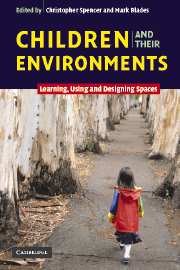Book contents
- Frontmatter
- Contents
- Notes on contributors
- An introduction
- Part I Children's understanding of places
- 1 Scale in children's experience with the environment
- 2 The problem of lost children
- 3 Children's understanding of environmental representations: aerial photographs and model towns
- 4 Children's knowledge of countries
- Part II Children's experience of places
- Part III Adolescents' worlds?
- Part IV Children and the design process
- Index
- References
1 - Scale in children's experience with the environment
Published online by Cambridge University Press: 23 October 2009
- Frontmatter
- Contents
- Notes on contributors
- An introduction
- Part I Children's understanding of places
- 1 Scale in children's experience with the environment
- 2 The problem of lost children
- 3 Children's understanding of environmental representations: aerial photographs and model towns
- 4 Children's knowledge of countries
- Part II Children's experience of places
- Part III Adolescents' worlds?
- Part IV Children and the design process
- Index
- References
Summary
Children's daily lives are complex, unique, and inherently spatial (Hart, 1979). Children explore the space around them even before they are mobile. Before they can locomote, or move from place to place (crawl, walk, run, etc.) independently, infants are interested in many of the things that fall within their reach. As will be discussed later, and as Piaget and others have suggested, these early explorations play an important role in how children come to know the world around them. One way we can understand the role that space plays in the lives of children is through scale. Scale provides a context within which spaces, places, and environments of different types can be integrated and better understood.
Definitions of scale and space
As valuable as scale is for understanding the relationships among different environments it is also a complex construct that has been extended to disparate classes of spaces, places, and geographies. For example, geographers study phenomena at various scales and often use the term scale to help define their research interests. Scale is also employed in many other disciplines to help define phenomena, concepts, interactions, and relationships. Lay definitions of scale, both related and unrelated to the stricter definitions employed in academic endeavours, also exist. For these reasons the use of the term scale varies in different contexts and can lead to confusion.
There have been a few attempts to categorize the nature of these different classes of definitions and provide a systematic understanding of scale across disciplines.
- Type
- Chapter
- Information
- Children and their EnvironmentsLearning, Using and Designing Spaces, pp. 13 - 25Publisher: Cambridge University PressPrint publication year: 2006
References
- 3
- Cited by

